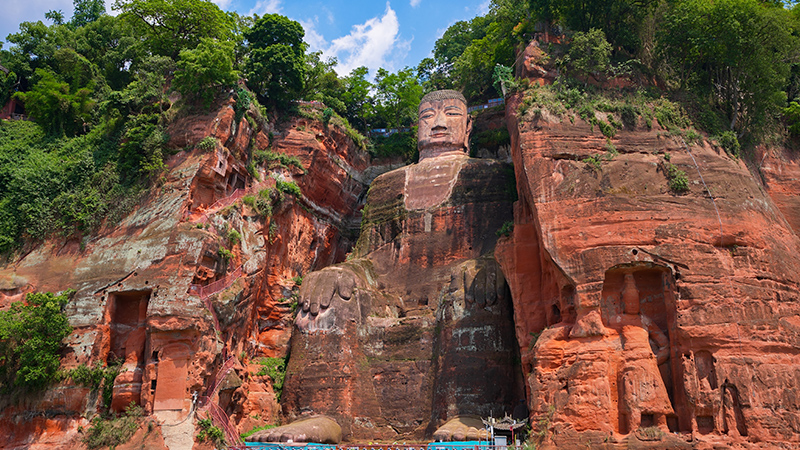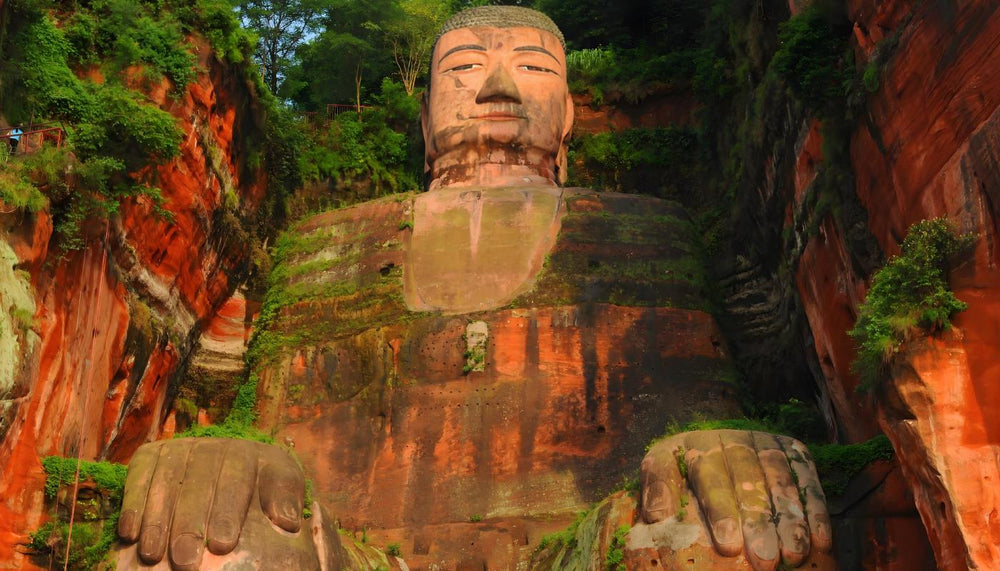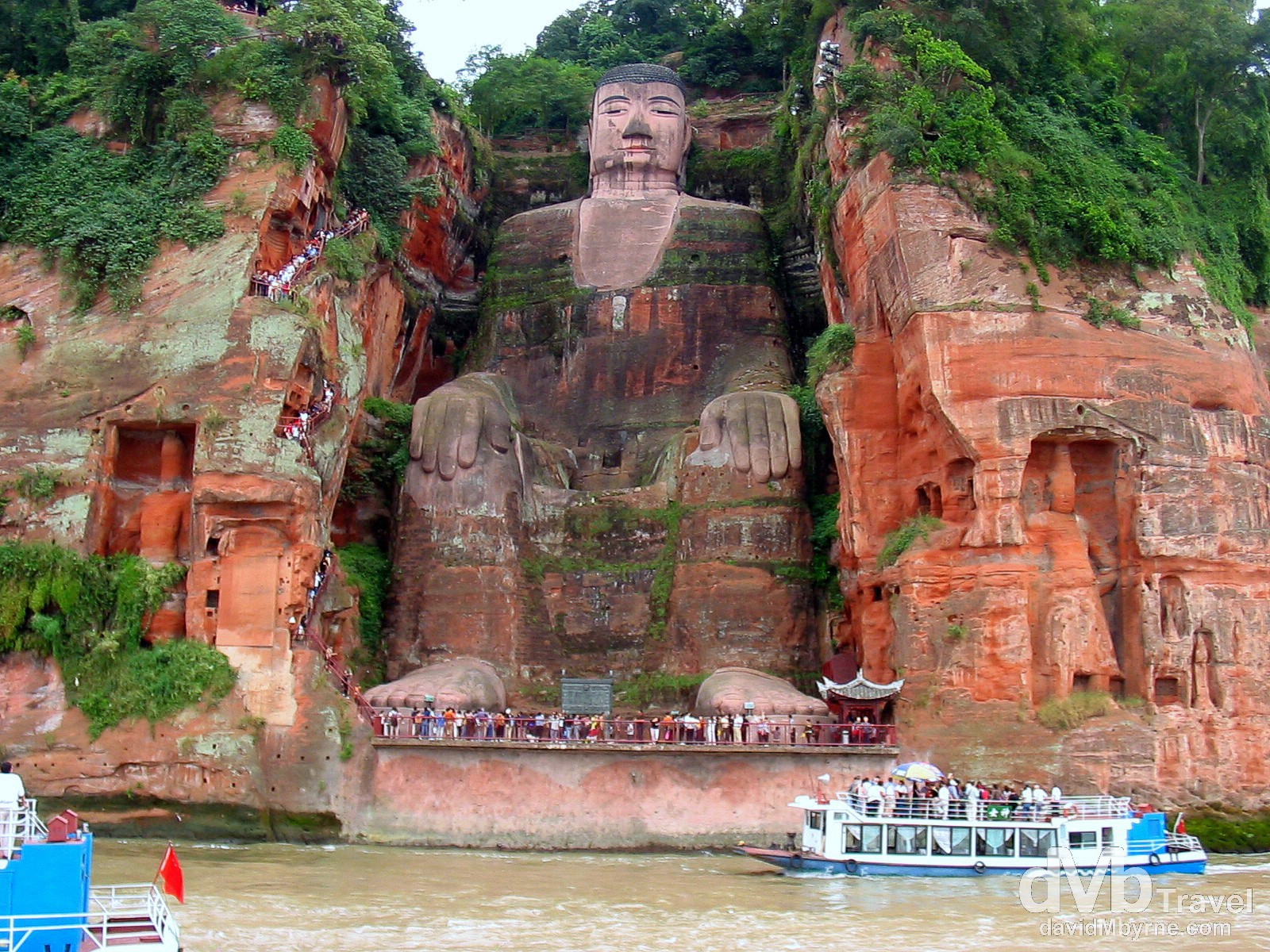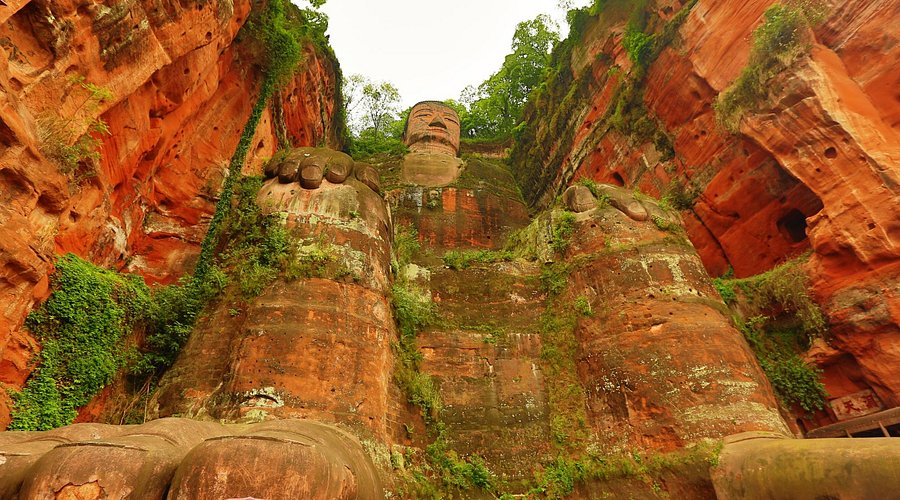Your Ultimate Guide to Experiencing the Leshan Giant Buddha

An Essential Guide to Visiting Leshan Giant Buddha
Nestled against the lush backdrop of Sichuan province, the Leshan Giant Buddha stands as a testament to human artistry and devotion. Carved from a sheer cliff face in the 8th century, this monumental figure stretches an impressive 71 meters tall, making it the largest stone Buddha statue in the world. A revered UNESCO World Heritage site, the Giant Buddha is not just a visual marvel but also a pilgrimage destination steeped in rich history and cultural significance.
Visiting the Leshan Giant Buddha offers travelers an unforgettable experience, blending stunning natural beauty with deep spiritual resonance. The journey to this iconic site is as rewarding as the destination itself, with various transport options available from nearby Chengdu. Whether you choose to approach on foot, meandering through scenic trails, or by boat for a unique perspective from the water, every moment spent in the presence of this ancient giant is bound to leave you in awe.
Prepare to embark on a journey that transcends time, where the serene expressions of the Buddha whisper tales of centuries past, and the vibrant atmosphere surrounding it invites you to reflect on your own path. In this essential guide, we will explore everything you need to know to make the most of your visit to the Leshan Giant Buddha, ensuring your experience is both enriching and memorable.
In This Guide
- An Essential Guide to Visiting Leshan Giant Buddha
- The Rich History and Legends of Leshan Giant Buddha
- Main Highlights: What You Absolutely Can’t Miss
- Planning Your Visit: A Practical Guide
- Tickets: Prices, Booking, and Tips
- How to Get There: A Complete Transportation Guide
- Local Cuisine and Accommodation Nearby
- Frequently Asked Questions
- Final Thoughts on Your Trip
The Rich History and Legends of Leshan Giant Buddha
Nestled in the picturesque landscape of Sichuan Province, the Leshan Giant Buddha stands as a monumental testament to the ingenuity and devotion of ancient artisans. Carved from the red sandstone cliff face of Lingyun Mountain, this colossal statue of Maitreya Buddha was commissioned during the Tang Dynasty (618-907 AD) in the 8th century. Its construction was initiated by a monk named Haitong, who sought to create a guardian figure to protect the vessels navigating the turbulent waters of the confluence of the Min, Dadu, and Qingyi rivers.
Haitong’s vision was grand; he believed that a massive Buddha would not only bring salvation to the troubled waters but also inspire a sense of tranquility among the local community. Despite facing numerous challenges—including a lack of resources and the daunting nature of the task—the monk persevered. Legend has it that Haitong, in his fervor, gouged out his own eyes to demonstrate his commitment to the project. His sacrifice, while tragic, became a poignant part of the Buddha’s story, symbolizing the depths of dedication and faith.
Construction of the statue began in 713 AD and took over 90 years to complete, with thousands of workers contributing to the laborious endeavor. As the statue rose, it became clear that the Leshan Giant Buddha was destined to be the tallest stone Buddha in the world, standing at an impressive 71 meters (233 feet). This monumental achievement not only surpassed the height of the Bamiyan Buddhas in Afghanistan but also dwarfed other renowned Buddhist sculptures, such as the Vairocana Buddha in the Longmen Grottoes.
Upon its completion, the Leshan Giant Buddha quickly became a site of pilgrimage and reverence for Buddhists and tourists alike. In 1996, it was designated a UNESCO World Heritage Site, recognized not only for its artistic brilliance but also for its cultural significance in the spread of Buddhism throughout the region.
The stories surrounding the Giant Buddha are as captivating as its grandeur. Local legends speak of the statue’s mystical powers—stories of sailors who have sailed safely past the treacherous waters after offering prayers to the Buddha. In the minds of many, it stands not just as a sculpture, but as a guardian spirit, watching over travelers and guiding them to safety.
Today, the Leshan Giant Buddha continues to attract visitors from around the globe, drawing both history enthusiasts and spiritual seekers. As you stand before this magnificent figure, you are not just gazing at a work of art; you are witnessing centuries of devotion, sacrifice, and the enduring spirit of human creativity. The Leshan Giant Buddha is more than a statue; it is a monumental narrative woven into the fabric of Chinese history, embodying the hopes and dreams of those who carved it from the mountainside.

Leshan Giant Buddha.
Main Highlights: What You Absolutely Can’t Miss
When visiting the Leshan Giant Buddha, there are several highlights that you absolutely cannot miss. This awe-inspiring site, carved over 1,200 years ago, offers a mesmerizing blend of history, culture, and natural beauty. Here’s what to prioritize during your visit:
1. The Giant Buddha Itself
The centerpiece of your visit is, of course, the Leshan Giant Buddha, standing at an impressive 71 meters (233 feet) tall. As the tallest stone Buddha statue in the world, it’s a sight that leaves visitors in awe. Take your time to absorb its grandeur and intricate details, from the serene expression on the Buddha’s face to the flowing robes and the massive hands that are larger than a car. Don’t forget to snap some photos—this is a moment to cherish!
2. Scenic Walking Paths
To reach the Buddha, you’ll traverse scenic walking paths that meander through lush forests and offer stunning viewpoints. The ascent is gradual, making it accessible for most visitors. Along the way, you’ll encounter smaller statues and temples, each adding to the spiritual ambiance of the site. The journey to the Buddha is just as rewarding as the destination itself.
3. Boat Tour on the Minjiang River
For a different perspective, consider taking a boat tour on the Minjiang River. This vantage point allows you to appreciate the scale of the Giant Buddha against the backdrop of the surrounding cliffs and lush greenery. The river journey provides an excellent photo opportunity and a serene experience as you glide past the statue and other nearby attractions.
4. The Lingyun Temple
Adjacent to the Giant Buddha is the Lingyun Temple, an ancient site that dates back to the same period as the Buddha. This temple is not only a place of worship but also a historical treasure. Explore its halls, observe the intricate carvings, and take in the peaceful atmosphere that envelops this sacred space.
5. Cultural Exhibits and Interpretive Center
Don’t miss the cultural exhibits near the entrance of the site. These provide insightful information about the history of the Giant Buddha, its construction, and its significance in Buddhist culture. The exhibits are well-presented and are a great way to enhance your understanding of this UNESCO World Heritage Site.
6. Mount Emei Nearby
If time allows, consider extending your visit to include Mount Emei, located just 45 minutes away. This sacred mountain is home to a wealth of Buddhist temples and stunning hiking trails. The combination of the Leshan Giant Buddha and Mount Emei makes for an unforgettable experience, showcasing the spiritual heart of Sichuan Province.
7. Local Cuisine
Finally, indulge in the local cuisine while you’re in the area. Leshan is famous for its spicy Sichuan dishes, particularly hotpot and dumplings. Be sure to try these local delicacies at one of the many eateries nearby, providing a delicious conclusion to your day of exploration.
As you plan your visit to the Leshan Giant Buddha, keep these highlights in mind to ensure a fulfilling and memorable experience. Whether marveling at the statue’s enormity, exploring the surrounding beauty, or immersing yourself in local culture, there’s no shortage of wonders to discover.

Leshan Giant Buddha.
Planning Your Visit: A Practical Guide
Visiting the Leshan Giant Buddha offers a unique glimpse into China’s rich cultural heritage and stunning natural beauty. To help you make the most of your trip, we’ve compiled essential information on how to plan your visit effectively.
Getting to Leshan
Location: The Leshan Giant Buddha is located in Leshan City, Sichuan Province, approximately 140 kilometers (about 87 miles) from Chengdu, the capital of Sichuan.
Transportation Options:
- By High-Speed Train:
- The fastest and most comfortable way to reach Leshan from Chengdu is via high-speed train. Trains depart from Chengdu East Railway Station throughout the day, with around 30 trains available. The journey takes approximately 1 hour.
-
If you’re near Chengdu South Railway Station, you can catch a train, but the frequency is lower compared to Chengdu East.
-
By Bus:
- Frequent buses run from Chengdu Xinnanmen Bus Station to Leshan. The bus ride takes about 2.5 hours and is a budget-friendly option.
-
Alternatively, you can take a taxi or a local tourist bus from Emeishan if you are visiting Mount Emei first.
-
By Car:
- Renting a car or hiring a driver to take you from Chengdu to Leshan is another convenient option. The drive usually takes around 2 hours.
When to Visit
Best Time: The ideal time to visit the Leshan Giant Buddha is during spring (March to May) and autumn (September to November) when the weather is mild, and the scenery is stunning. Summers can be quite hot, while winters may bring chilly temperatures.
Entrance and Ticket Information
- Admission Fee: Purchase your tickets at the entrance. The fee is reasonable and grants you access to the scenic area surrounding the Buddha.
- Opening Hours: The site is typically open from 6:30 AM to 6:30 PM, but it’s advisable to check for any seasonal changes in hours.
Exploring the Site
Visitors have two main options to see the Giant Buddha:
- On Foot:
-
Walking is the most common method to explore the site. After entering through the north gate, you will follow paths that gradually incline to the viewing areas. This option, while time-consuming, allows for a more immersive experience as you encounter various viewpoints and smaller sculptures along the way.
-
By Boat:
- For a different perspective, consider taking a boat ride on the river. This option provides stunning views of the Buddha from below and can be less physically demanding than hiking.
Tips for a Great Visit
- Wear Comfortable Shoes: Whether you’re hiking the paths or exploring the surrounding areas, comfortable footwear is essential.
- Stay Hydrated: Bring water, especially during warmer months. There are limited facilities along some paths.
- Plan for Crowds: The Giant Buddha is a popular destination, so visiting early in the morning or later in the afternoon can help you avoid the busiest times.
- Combine with Mount Emei: If time permits, consider visiting Mount Emei, another UNESCO World Heritage Site located just 45 minutes away. You can easily plan a combined tour to maximize your experience.
Additional Considerations
- Language: While some signs are in English, learning a few basic Mandarin phrases can enhance your experience and interaction with locals.
- Cultural Respect: As a significant Buddhist site, maintain a respectful demeanor during your visit. Dress modestly, and be mindful of local customs.
By following this guide, you can ensure a fulfilling and enjoyable visit to the Leshan Giant Buddha, immersing yourself in its majesty and the serene beauty of the surrounding landscape. Enjoy your journey!

Leshan Giant Buddha.
Tickets: Prices, Booking, and Tips
Visiting the Leshan Giant Buddha is a breathtaking experience, and having the right information about tickets will help ensure a smooth journey.
Ticket Prices
As of the latest updates, the entrance fee to the Leshan Giant Buddha Scenic Area is approximately 80 CNY (about $12 USD). This ticket grants you access to the main viewing areas, including the paths leading to the Buddha and the scenic spots surrounding it. Additionally, if you’re interested in a boat ride to see the Giant Buddha from the water, you can expect to pay around 70 CNY (approximately $10 USD) for that experience.
Booking Tickets
Tickets can be purchased on-site at the entrance gates, yet it’s advisable to buy them in advance during peak travel seasons (like summer and major holidays) to avoid long queues. You may also find several online platforms that offer ticket bookings, which can save you time. If you are part of a tour group, tickets are often included in the package, so check with your tour operator for details.
Tips for a Seamless Experience
- Plan Your Visit: The best time to visit is early in the morning or late in the afternoon. These times often see fewer tourists, allowing you to enjoy the site more peacefully.
- Weather Considerations: Check the weather forecast before your visit. The paths can be slippery in rainy conditions, so wear appropriate footwear.
- Bring Cash: Although many places may accept digital payments, having cash on hand for ticket purchases and small vendors is a wise choice, especially in more rural areas.
- Explore Beyond the Buddha: The area around the Giant Buddha is rich with cultural and natural attractions, including Mount Emei—a UNESCO World Heritage Site. Consider allocating extra time to explore this stunning landscape.
By keeping these details in mind, you’ll be well-prepared to enjoy one of China’s most remarkable landmarks!
How to Get There: A Complete Transportation Guide
To reach the majestic Leshan Giant Buddha, a UNESCO World Heritage Site and the tallest Buddha statue in the world, travelers have several convenient options. Nestled about 140 kilometers from Chengdu and easily accessible from nearby cities, planning your journey can enhance your experience at this remarkable destination.
From Chengdu to Leshan
By High-Speed Train
Taking a high-speed train is one of the most efficient and comfortable ways to travel from Chengdu to Leshan.
- Departure Station: Chengdu East Railway Station (with some trains stopping at Chengdu Shuangliu International Airport).
- Frequency: Approximately 30 daily trains.
- Travel Time: Around 1 hour.
- Tips: Aim for trains that do not stop at the airport for a quicker journey. The first train generally departs around 6:30 AM.
Upon arrival at Leshan Railway Station, which is about 13 kilometers from the Giant Buddha, you can choose from the following transportation options:
- Taxi: A quick and convenient choice for direct transport.
- Local Buses: Take Bus 605 or Bus 3 for a budget-friendly option.
By Bus
If you prefer a more economical method, taking a bus is a viable alternative:
- Departure Point: Chengdu Xinnanmen Bus Station.
- Travel Time: Approximately 2.5 hours.
- Cost: Generally cheaper than train tickets.
- Note: While the bus journey is longer, it can be a scenic route and may be suitable if train tickets are fully booked.
From Emeishan to Leshan
If you’re exploring Mount Emei, you can easily continue your journey to the Leshan Giant Buddha:
By High-Speed Train
- Departure Station: Emeishan High-Speed Railway Station, located approximately 2 kilometers from the Mount Emei tourist center.
- Frequency: Typically three trains daily.
- Travel Time: About 15–20 minutes.
- Tips: This option is quick and convenient after a day of hiking at Mount Emei.
By Taxi or Tourist Bus
- Travel Time: Approximately 45 minutes by taxi or tourist bus from Mount Emei to Leshan.
- Recommendation: Taxis are more comfortable and faster, but buses are a cost-effective option.
Additional Travel Tips
- Driving: If you prefer the flexibility of a car, driving from Chengdu or Emeishan is a great option. The drive typically takes around 2 hours from Chengdu and 45 minutes from Emeishan.
- Local Transportation: Once you arrive at the Leshan Giant Buddha site, visitors have the choice to explore on foot or take a scenic boat ride to view the statue from the river—a unique perspective that shouldn’t be missed.
Conclusion
Regardless of your choice of transportation, visiting the Leshan Giant Buddha is an unforgettable experience. With options ranging from high-speed trains to scenic bus rides, you can easily immerse yourself in the beauty of this historic site. Plan your journey ahead to ensure a smooth and enjoyable visit!

Leshan Giant Buddha.
Local Cuisine and Accommodation Nearby
When visiting the majestic Leshan Giant Buddha, indulging in the local flavors and enjoying comfortable accommodations nearby can significantly enhance your travel experience. Here’s a curated selection of delectable dishes and cozy places to stay in the vicinity.
Local Cuisine
Sichuan cuisine is renowned for its bold flavors, particularly its spicy and numbing characteristics, thanks to the use of Sichuan peppercorns and chili peppers. Here are some must-try dishes while in Leshan:
-
Leshan Bean Curd (乐山豆腐) – A local specialty, this dish features soft tofu that’s marinated and stir-fried with an array of spices and fresh vegetables, resulting in a delightful combination of textures and flavors.
-
Spicy Noodle Soup (辣味面条) – Perfect for those who crave warmth, this dish is loaded with chewy noodles, fresh herbs, and a rich, spicy broth that reflects the essence of Sichuan’s culinary heritage.
-
Sichuan Hot Pot (四川火锅) – Gather your friends or family for a communal dining experience at one of the many hot pot restaurants. Choose from a variety of meats, vegetables, and dipping sauces, and enjoy the fun of cooking at your table.
-
Pickled Vegetables (泡菜) – These tangy and spicy pickles are a common side dish in Sichuan cuisine. They provide a refreshing contrast to the rich and spicy main courses.
-
Dandan Noodles (担担面) – A street food classic, these noodles are served in a savory sauce made from sesame paste, chili oil, and ground meat, topped with chopped peanuts for a satisfying crunch.
Accommodation Options
After a day of marveling at the Giant Buddha, retreat to one of these comfortable accommodations that cater to a variety of budgets:
-
Leshan Grand Hotel (乐山大酒店)
A short drive from the Giant Buddha, this hotel offers modern amenities and spacious rooms with stunning views of the surrounding mountains. The on-site restaurant serves a mix of Chinese and Western cuisine. -
Hanting Hotel Leshan (汉庭酒店)
Ideal for budget-conscious travelers, Hanting Hotel provides clean, comfortable rooms and convenient access to local attractions. Its friendly staff can help you navigate the area easily. -
Emeishan Jinyuan Hotel (峨眉山金源酒店)
Located near Mount Emei, this hotel offers a tranquil setting with easy access to both the Giant Buddha and the mountain. The rooms are tastefully decorated, and the hotel features a delightful restaurant serving local dishes. -
Leshan Shunyi Hotel (乐山顺意酒店)
This mid-range hotel is known for its excellent service and cozy atmosphere. Each room is equipped with modern comforts, and the hotel’s proximity to the Leshan Giant Buddha makes it a convenient choice. -
Hostel Option: Leshan Youth Hostel (乐山青年旅舍)
For a more social atmosphere, consider staying at this hostel. It’s perfect for solo travelers or those looking to meet fellow adventurers. The hostel organizes tours and provides easy access to local eateries.
Conclusion
With its rich culinary offerings and a range of accommodations, Leshan is a destination that caters to all types of travelers. Savor the local dishes and enjoy a comfortable stay as you explore the wonders of the Leshan Giant Buddha and the surrounding area.

Leshan Giant Buddha.
Frequently Asked Questions
-
What is the best time to visit the Leshan Giant Buddha?
The ideal time to visit the Leshan Giant Buddha is during spring (March to May) and autumn (September to November) when the weather is mild and pleasant. These seasons also attract fewer tourists compared to the summer months, allowing for a more serene experience. -
How do I get to the Leshan Giant Buddha from Chengdu?
You can easily reach the Leshan Giant Buddha from Chengdu by high-speed train, which takes about one hour. Alternatively, you can opt for a two-hour drive, or take a bus from Chengdu Xinnanmen Bus Station, which takes around 2.5 hours. Choose the mode of transportation that best suits your schedule and comfort level. -
Are there entrance fees to visit the Giant Buddha?
Yes, there is an entrance fee to access the scenic area around the Leshan Giant Buddha. As of now, tickets are approximately 90 RMB (around $14), but it’s always wise to check for any updates or changes before your visit. -
Can I hike to the Giant Buddha, and how long will it take?
Yes, you can hike to the Giant Buddha! The footpath leading to the statue is well-maintained but can be steep in some sections. The hike can take anywhere from 30 minutes to an hour, depending on your pace and physical condition. -
Is it possible to take a boat tour to see the Buddha?
Absolutely! Boat tours are a popular option that allows you to see the Giant Buddha from the river. These tours typically last around 30 minutes and provide a unique perspective of this monumental sculpture. Be sure to check the weather and boat schedules on the day of your visit. -
What should I wear while visiting the Leshan Giant Buddha?
Dress comfortably and wear sturdy shoes, as you will be walking and possibly hiking. If you’re visiting during the warmer months, lightweight clothing is advisable. Don’t forget to bring a hat, sunglasses, and sunscreen to protect yourself from the sun. -
Are there accommodations nearby for an overnight stay?
Yes, there are various accommodations near the Leshan Giant Buddha ranging from budget hostels to mid-range hotels and luxury resorts. Staying overnight allows you to explore the area more leisurely and even visit Mount Emei, another UNESCO World Heritage Site, which is just a short distance away. -
Can I visit the Leshan Giant Buddha and Mount Emei in one trip?
Definitely! Many travelers choose to combine their visit to the Leshan Giant Buddha with a trip to Mount Emei, as they are located relatively close to each other. Consider booking a guided tour that includes both sites for a well-rounded experience of these magnificent landmarks.
Final Thoughts on Your Trip
As you wrap up your journey to the majestic Leshan Giant Buddha, take a moment to reflect on the awe-inspiring experience that awaits every traveler. Standing at an impressive 71 meters, this ancient marvel not only exemplifies the incredible artistry of its time but also serves as a reminder of the enduring power of faith and devotion across centuries.
Whether you’ve traversed the scenic pathways on foot, taken a tranquil boat ride along the river, or simply marveled at its grand stature from afar, the Giant Buddha offers a unique perspective on the rich tapestry of Chinese culture and history. Paired with the serene beauty of Mount Emei, this UNESCO World Heritage site invites you to delve deeper into the spiritual and natural wonders of Sichuan.
As you journey back, remember the stories etched into the stone and the tranquility that envelops this sacred site. The Leshan Giant Buddha is not just a destination; it is an experience that lingers long after your visit. May the memories of this incredible landmark inspire you to explore more of the world’s hidden treasures, each with their own tales waiting to be discovered. Safe travels!